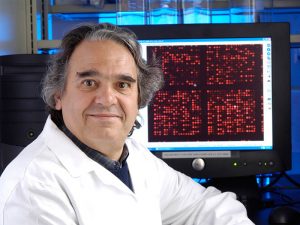This week, Nature reported on two institutional reports that found scientists in Carlo Croce’s cancer research lab at The Ohio State University had committed research misconduct including plagiarism and data falsification.
Another institutional investigation directed at Croce did not find he committed research misconduct but did identify problems with how he managed his lab, according to Nature.
It’s the latest chapter in a years-long saga of mounting numbers of corrections and retractions for Croce, a 2017 article in the New York Times that brought him to widespread attention, a scientist sleuth trying to clean up the literature, and lots and lots of lawyers, some of whom may have a claim on Croce’s house after he didn’t pay his legal bills.
Croce, as we’ve previously reported, earns more than $800,000 per year from OSU. He was forced to step down as department chair in 2018, and lost a legal bid to be reinstated. Nature reports that he is now suing OSU to be reinstated to an endowed chair he had also lost.
In late May, through a public records request, we obtained one of the reports Nature reported on this week. That investigation, found research misconduct by Michela Garofalo, a former postdoc and later research scientist in Croce’s lab, and we have made it available here. (We just haven’t had time to fully report the story yet; it’s a great example of what our co-founder wrote about in this April appeal for donations.)
The investigation began in 2017 and concluded last year. OSU found that Garofalo “intentionally, knowingly, and/or recklessly plagiarized text from various sources” in seven published papers and that she was responsible for image falsification in two papers. For one allegation, the investigation committee could not determine whether Garofalo was responsible for image reuse between two papers because she had a co-first author on one of the papers.
The investigation committee recommended correcting or retracting nine papers, and that Garofalo permanently be ineligible for rehire at the university.
Only one paper, published in PLOS ONE, has been retracted so far. We also obtained emails between the journal and OSU about the paper which offer a window into the retraction process. The journal’s own investigation took five months from November 2021 to April of this year and involved back-and-forth between the publication ethics team and the OSU staffers about the university’s findings and Garofalo’s defense.
Garofalo told Nature that the OSU investigation findings were “false and discriminatory,” and that “legal action will be taken.” She worked at the Cancer Research UK Manchester Institute at the University of Manchester from 2014-2020, Nature reported, and wouldn’t say where she now works.
David Sanders, a data sleuth and biologist at Purdue University who raised issues about Garofalo’s papers with OSU and the journals that published them, told Retraction Watch that he thought the investigation of Garofalo’s work “mostly came to the right conclusions.”
But Sanders, whom Croce sued along with the New York Times unsuccessfully for defamation, expressed frustration that journals have been slow to act on the findings:
As far as I can tell, retractions, corrections have been requested for all of these articles, and other articles as well, and they haven’t been happening.
There was no reason for it to be delayed this long, but once OSU has made their conclusion, there’s absolutely no reason for them to be held up any further.
I’m afraid that one of the things that might be going on here, is that one or more authors has decided to use the legal system to try to interfere with the scientific correction process.
In some cases, such as a 2012 Nature Medicine paper that OSU found has a falsified dendrogram/heatmap, “it was blatantly obvious there was image duplication and yet some of [the journals] still haven’t taken any action on these issues,” Sanders said.
The Nature Medicine paper, which has Garofalo as the first and Croce as the final and corresponding author, was corrected in 2014. In March the journal published an editor’s note saying “that concerns have been raised about the integrity of images in this paper” and the editors were reviewing them, with further action to follow after the review concluded.
When journals say they don’t have the “resources” to investigate allegations in a timely manner, Sanders said:
My argument is if you don’t have the resources to deal with problematic past articles, you should stop publishing articles until you have cleaned up the past. Put your resources into dealing with those issues.
Why should it take so long to correct the literature when they are publishing things after a few weeks of review?
Sanders also expressed concern that after receiving allegations of image manipulation in a paper, journals often allow the authors to publish corrections with new data, when those new figures may also be manipulated:
When dealing with these sorts of image manipulation problems, there is a breakdown in the trust between the reader and the authors, and there should be a breakdown of trust between the journal and authors.
For them to just accept some substitute data – and we’ve seen this as a problem in articles as part of this process – why do you think it’s right this time? How do you really know these are the correct data?
Like Retraction Watch? You can make a tax-deductible contribution to support our work, follow us on Twitter, like us on Facebook, add us to your RSS reader, or subscribe to our daily digest. If you find a retraction that’s not in our database, you can let us know here. For comments or feedback, email us at [email protected].


Is the resistance to corrections possibly due to journals’ desire to maintain esteem among readers who don’t yet know they maintain fabricated articles? Or is it just because they answer to no overarching authority and it takes up valuable time?
I suspect both these aspects might be at play. In an open access journal, where the authors are the paying customers, there is no immediate revenue coming in from dealing with corrections and retractions. So these things will get low priority. But I think the keeping up appearances aspect is probably the main point. Journals and editors consider it a blame for themselves if they have to retract a paper. Which might be true in some cases, if the peer review was handled badly.
In my opinion though, well crafted frauds are impossible to detect through peer-review, and the whole system of peer-review was never intended for that purpose. Reviewers have to work in the assumption that a paper is trying to present honest science.
Journals and editors who are willing to deal with frauds and fakes in a correct matter should be lauded for that, and I think in general they are. So I think that the reluctance to retract papers for fear of loosing prestige is misguided.
“Croce, as we’ve previously reported, earns more than $800,000 per year from OSU.”
If you please: he is (apparently) paid more than $800,000 per year by OSU. The production and/or supervision of fraudulent papers is not science (the activities for which I assume he is mostly paid), it is anti-science, in that it requires (others’) hard work to restore the published record back up to the level it would have had if his activities had never taken place.
Who is sleuth?
“David Sanders, a data sleuth and biologist at Purdue University”
“As far as I can tell, retractions, corrections have been requested for all of these articles, and other articles as well, and they haven’t been happening. “
Journals like Nature ask for exorbitant prices for subcriptions while profiting from the work of others. Block content and merciless chase sites as sci-hub…. So they are the last ones who can argue for a “lack of resources” in performing what is actually the only work that they are expected to do…. Shame on them
Well, the LinkedIn profile for Michela Garofalo says she’s been working for Cancer Research UK since 2014, but the Cancer Research UK website (www.cancerresearchuk.org) does not have her listed in its online list of researchers. I checked out archive.org and it has (so far) 15 captures since 2015, and her name does not appear in any of them — though for what it’s worth, the website states, in referring to a list of researchers, “here’s a selection of some of them”, which implies that it’s not actually complete.
(Note: I find it interesting that she hasn’t appeared on the list even during the time “Nature” reported that she was working there. Again, it’s no indication that she wasn’t [the website states the list contains “some” of the list], but it’s still interesting to me.)
who cares?
Hi Kat P. – I admire your skepticism; I’d just point out that there’s plenty of online evidence that Garofalo did work at the CRUK Manchester Institute. For instance, in 2015, the University of Manchester press-released work by Garofalo in PNAS, which stated that she’d led the research. And in 2019, CRUK Manchester Institute tweeted out a job advert: “We have a very exciting opportunity to join Dr Michela Garofalo’s group!” Finally, she was listed as “Leader of the Transcriptional Networks in Lung Cancer group at the Cancer Research UK Manchester Institute” on a website that was remarkably still online in 2022, but since my story has been removed. You can see it via the WayBack Machine (e.g. https://web.archive.org/web/20210123084543/http://www.cruklungcentre.org/Research/Basic-Science ).
Richard Van Noorden.
Once more, kudos to Prof. Sanders for his outstanding contributions to scientific integrity. The Croce story has been hair-raising from the start. But, it is encouraging (to those of us who also care about scientific integrity) that Croce did not prevail in using the legal system to get out of accountability (though the legal system is apparently still being used to slow the correction process).
How much did OSU pay for the writing of this article? It is quite nauseating to see that the website of Nature allows the publication of these commissioned articles instead of focusing on real science. Another false investigation orchestrated by a committee of men from a mediocre Institution (OSU) to protect a big professor that has brought to the stake two young successful independent women. After four years of investigation, OSU continues to protect Croce and incriminates only postdocs – what about the other 100 articles present in pubpeers that Dr Pichiorri and Dr Garofalo did not write? What about the people authoring many of the articles retracted and corrected that still work at OSU???
The Nature Medicine paper was just retracted.
I reported an anomaly in a PNAS paper from this group (that paper had questionable western blots; I reported another issue). PNAS never responded about this.
The same is true for a number of articles by Christian Kreipke published in Neurological Research. In one issue of the journal Kreipke’s group published multiple papers and the same images were used in several of those papers, sometimes purporting to represent different results.. the journal and its editor in chief have been alerted to this many times. The EiC did not respond and the publisher said they would look into the situation. After 7 years since Neuro Res was informed, there is still no action and these papers remain unflagged.
There do seem to be retractions in Neurological Research. See PubPeer search here: https://pubpeer.com/search?q=Christian+Kreipke
Or the Retraction Watch Database, which lists four. http://retractiondatabase.org/RetractionSearch.aspx#?auth%3dKreipke%252c%2bChristian%2bW
All four entries link to a 2017 post on this: https://retractionwatch.com/2017/03/02/researcher-lost-whistleblower-lawsuit-logs-4-retractions/
Every story has two sides. Readers should review this recently published article that discusses both the NYT article and DA Sanders (see link below), the main accuser of Dr Croce, compare it to what they read here, and form their own conclusion
Here is the article: https://columbusfreepress.com/article/how-new-york-times-got-it-so-wrong-politicization-scientific-misconduct..
Important context about this article here: https://retractionwatch.com/2023/08/14/lawyers-can-foreclose-on-cancer-researchers-house-for-unpaid-defamation-suit-bills-says-judge/#comment-2186275